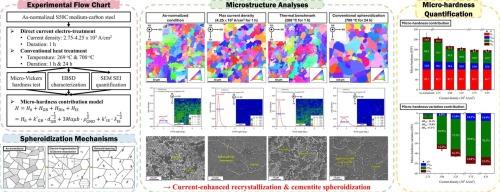Electro-spheroidization effects on the mechanical property and microstructures in S50C medium‑carbon steels: A comparison with conventional subcritical spheroidization
IF 5.5
2区 材料科学
Q1 MATERIALS SCIENCE, CHARACTERIZATION & TESTING
引用次数: 0
Abstract
This study systematically investigated the microstructure evolution and mechanical softening of normalized S50C medium‑carbon steels subjected to direct current electro-treatment at current densities of 2.75–4.25 × 103 A/cm2 for 1 h. Compared to conventional subcritical spheroidization (700 °C for 24 h), electro-treatment achieved a 24.1 % micro-hardness reduction to 157.8 ± 0.6 HV at a significantly lower processing temperature (268.8 °C) and 96 % shorter duration. Electron backscatter diffraction analyses revealed complete ferrite recrystallization at high current densities, accompanied by grain boundary rearrangement and dislocation annihilation. Concurrently, the cementite morphology evolved from lamellar to spheroidized, with the spheroidization rate increasing from 3.4 ± 0.8 % to 99.5 ± 3.4 %, and the interlamellar spacing of pearlite expanding from 0.37 ± 0.10 μm to 1.45 ± 0.32 μm. These transformations followed a two-stage mechanism: electro-fragmentation at a moderate current density (2.75 × 103 A/cm2) and Ostwald ripening at higher levels (3.00–4.25 × 103 A/cm2). A composite Hall-Petch, Bailey-Hirsch, interlamellar spacing based model quantitatively captured the micro-hardness contributions from grain boundary strengthening, strain hardening, and interlamellar cementite strengthening in dual-phased medium‑carbon steels. A thermal benchmark experiment at 269 °C for 1 h confirmed that Joule heating alone could not trigger the observed changes, underscoring the dominant role of athermal effects in metallurgical behaviors. Literature-based thermodynamic analysis further suggests that electro-treatment introduces additional free energy, promoting interface destabilization and accelerated phase transformations. Overall, this method enables effective spheroidization and recrystallization while preventing severe grain growth, offering a low-temperature and high-efficiency alternative for sustainable processing of medium‑carbon steels.

电球化对S50C中碳钢力学性能和组织的影响:与常规亚临界球化的比较
本研究系统地研究了正火S50C中碳钢在电流密度为2.75-4.25 × 103 A/cm2的直流电处理下1小时的显微组织演变和机械软化。与传统的亚临界球化(700°C 24小时)相比,电处理在显著降低的加工温度(268.8°C)和缩短96%的时间下,显微硬度降低24.1%至157.8±0.6 HV。电子背散射衍射分析显示在高电流密度下铁氧体完全再结晶,伴随着晶界重排和位错湮灭。同时,渗碳体形貌由层状向球化演变,球化率由3.4±0.8%增加到99.5±3.4%,珠光体层间间距由0.37±0.10 μm扩大到1.45±0.32 μm。这些转变遵循两个阶段的机制:中等电流密度(2.75 × 103 a /cm2)下的电碎裂和更高电流密度(3.00-4.25 × 103 a /cm2)下的奥斯特瓦尔德成熟。基于复合Hall-Petch, Bailey-Hirsch的层间间距模型定量捕获了双相中碳钢的晶界强化、应变硬化和层间渗碳体强化对显微硬度的贡献。在269℃下1 h的热基准实验证实,焦耳加热本身不能触发观察到的变化,强调了非热效应在冶金行为中的主导作用。基于文献的热力学分析进一步表明,电处理引入了额外的自由能,促进了界面的不稳定和加速了相变。总的来说,这种方法可以有效地实现球化和再结晶,同时防止严重的晶粒生长,为中碳钢的可持续加工提供了一种低温高效的替代方案。
本文章由计算机程序翻译,如有差异,请以英文原文为准。
求助全文
约1分钟内获得全文
求助全文
来源期刊

Materials Characterization
工程技术-材料科学:表征与测试
CiteScore
7.60
自引率
8.50%
发文量
746
审稿时长
36 days
期刊介绍:
Materials Characterization features original articles and state-of-the-art reviews on theoretical and practical aspects of the structure and behaviour of materials.
The Journal focuses on all characterization techniques, including all forms of microscopy (light, electron, acoustic, etc.,) and analysis (especially microanalysis and surface analytical techniques). Developments in both this wide range of techniques and their application to the quantification of the microstructure of materials are essential facets of the Journal.
The Journal provides the Materials Scientist/Engineer with up-to-date information on many types of materials with an underlying theme of explaining the behavior of materials using novel approaches. Materials covered by the journal include:
Metals & Alloys
Ceramics
Nanomaterials
Biomedical materials
Optical materials
Composites
Natural Materials.
 求助内容:
求助内容: 应助结果提醒方式:
应助结果提醒方式:


